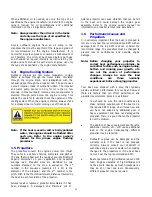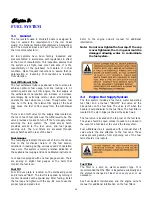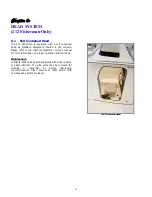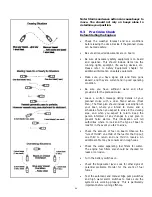
Chapter 4:
ELECTRICAL SYSTEMS
4.1
General
Your boat is designed for 12-volt lead acid, wet cell
marine batteries. They will require similar maintenance
as those found in automobiles. You should not mix the
size or brand of the wet cell batteries. Always consult
your Wellcraft dealer before changing the type of
batteries in your boat.
All wires in the electrical systems are color coded to
make identifying circuits easier. Wiring schematics and a
wire code identification list have been included with this
manual to aid in following an individual circuit of the
boat.
4.2
12-Volt System
The 12-volt system is a typical marine system equipped
with two batteries. The batteries are charged by the
engine.
All 12-volt power is distributed to the 12-volt accessories
through individual circuit breakers located in the head
compartment near the battery switch. Main fuses protect
the primary DC circuits from an overload.
Battery Switch
The battery switch (OFF - 1 - 2 – BOTH) is located in the
head compartment. The following is a general usage of
this battery switch.
In the OFF position, the two batteries are disconnected
from all loads. The OFF position is used when the boat is
being stored or otherwise not in use. It prevents any
drain from the batteries. This can be useful if a circuit
has been accidentally left on, say a cabin lighting circuit
or similar drain. Such a load can completely discharge a
battery in a day or two, leading to an unanticipated dead
battery situation when you return to your boat.
In the 1 position, all loads and charging currents are
connected to the No. 1 battery. Starting current for the
engine starter motor is supplied by the PORT battery.
When the engine is running, surplus current developed
by its charging circuit will flow into the PORT battery.
Current to lighting and other loads will flow from the
PORT battery. The STDB battery is completely isolated
and has no load current, nor does it receive any
charging current.
In the 2 position, all loads and charging currents are
connected to the No. 2 battery. Now it supplies current
required by starting and running, and it receives all the
charging current from the engine. The PORT battery is
totally isolated.
In the BOTH position, the two batteries are connected
in parallel. This has a number of implications. Unless the
batteries have exactly the same state of charge, the
combined voltage to the two batteries in parallel will sag
to a voltage somewhat lower than the highest battery's
terminal voltage. Current from the higher voltage battery
will flow into the lower voltage battery and begin
charging it. As long as the state of charge in one battery
is higher than the other, the lower battery is more of a
load than a source of power. Eventually, the batteries
will reach equilibrium, and they will both have the same
terminal voltage. At that point they will both tend to
supply current to loads that are attached to them, and
they will both receive charging current furnished by the
engine.
It would seem like operating in the BOTH position would
be beneficial, but that is not always the case. Even
thought the batteries will eventually rise or fall to the
same terminal voltage when connected together, they
will not necessarily become exactly the same. A battery
(or any source of electrical energy) can be though of as
having an internal resistance. The lower this internal
resistance the greater the current it can supply. The
internal resistance will also affect how the battery
absorbs charging current. Even though they are
connected in parallel, it is possible that they will supply
unequal currents to the loads, and it is also possible that
they will accept unequal currents from the engine
charging source.
If the batteries are significantly different in their age,
their type of construction, and their state of charge, this
unequal distribution of current can be more significant.
To describe the situation in the simplest of terms, when
two batteries are connected in parallel, they will
probably tend to behave more like the weakest battery
of the two than the strongest.
Paralleling the batteries can come in handy in some
situations. For example, both batteries may be
discharged to a point where neither alone can provide
enough current to crank the starter motor, but combined
in parallel they can turn the engine over.
31
Summary of Contents for 180 Sportsman
Page 2: ...2...
Page 4: ...4...
Page 7: ...180 FISHERMAN SPECIFICATIONS 7...
Page 8: ...180 SPORTSMAN SPECIFICATIONS 8...
Page 9: ...202 FISHERMAN SPECIFICATIONS 9...
Page 10: ...212 FISHERMAN SPECIFICATIONS 10...
Page 18: ...18...
Page 39: ...SAFETY LABELS 2601 1124 39...
Page 40: ...180 FISHERMAN 180 SPORTSMAN CAPACITY LABELS 40...
Page 41: ...202 212 FISHERMAN CAPACITY LABELS 41...
Page 61: ...Appendix A SCHEMATICS 180 FISHERMAN INSTRUMENT PANEL 61...
Page 62: ...Appendix A SCHEMATICS 180 SPORTSMAN INSTRUMENT PANEL 62...
Page 63: ...Appendix A SCHEMATICS 202 212 FISHERMAN INSTRUMENT PANEL 63...
Page 68: ...Appendix A SCHEMATICS 180 FISHERMAN 180 SPORTSMAN TRAILER DRAWING 68...
Page 69: ...Appendix A SCHEMATICS 202 212 FISHERMAN TRAILER DRAWING 69...
Page 70: ...Appendix A SCHEMATICS 180 FISHERMAN OVERHEAD LAYOUT 70...
Page 71: ...Appendix A SCHEMATICS 180 SPORTSMAN OVERHEAD LAYOUT 71...
Page 72: ...Appendix A SCHEMATICS 202 FISHERMAN OVERHEAD LAYOUT 72...
Page 73: ...Appendix A SCHEMATICS 212 FISHERMAN OVERHEAD LAYOUT 73...
Page 77: ...MAINTENANCE LOG 77...
Page 78: ...MAINTENANCE LOG 78...
Page 80: ...Appendix D BOAT ACCIDENT REPORT 80...
Page 81: ...81...
Page 87: ...Appendix F TROUBLESHOOTING GUIDE 87...
Page 88: ...TROUBLESHOOTING GUIDE 88...
Page 89: ...TROUBLESHOOTING GUIDE 89...
Page 90: ...TROUBLESHOOTING GUIDE 90...
Page 91: ...TROUBLESHOOTING GUIDE 91...
















































